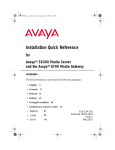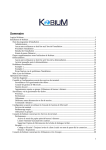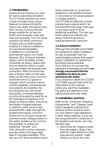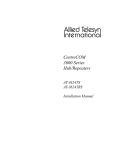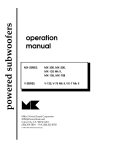Download Sharp R-360EW Specifications
Transcript
GTQ 360 new 7/17/98 10:44 AM Page 1 GRAND TOURING SERIES 4/3/2 Channel Automotive Power Amplifier GT Q 3 6 0 , GT Q 2 4 0 O w n e r ’ s M a n u a l GENUINE JBL GTQ 360 new 7/17/98 10:44 AM Page 2 1. Introduction . . . . . . . . . . . . . . . . . . . . . . . . . . . . . . . . . . . . . . . . . . . . . . . . . . . . . . . . . 3 1.1 Thanks . . . . . . . . . . . . . . . . . . . . . . . . . . . . . . . . . . . . . . . . . . . . . . . . . . . . . . . . . . 3 1.2 About Installation . . . . . . . . . . . . . . . . . . . . . . . . . . . . . . . . . . . . . . . . . . . . . . . . . 3 2. Installation and Use . . . . . . . . . . . . . . . . . . . . . . . . . . . . . . . . . . . . . . . . . . . . . . . . . . . 2.1 ................................................................ 3 3 2.2 Controls and Connectors . . . . . . . . . . . . . . . . . . . . . . . . . . . . . . . . . . . . . . . . . . . 4 3. System Design Using the GTQ360 and GTQ240 . . . . . . . . . . . . . . . . . . . . . . . . . . . . 4 3.1 Speaker Requirements . . . . . . . . . . . . . . . . . . . . . . . . . . . . . . . . . . . . . . . . . . . . 4 3.2 Signal Sources . . . . . . . . . . . . . . . . . . . . . . . . . . . . . . . . . . . . . . . . . . . . . . . . . . . 5 4. Wiring . . . . . . . . . . . . . . . . . . . . . . . . . . . . . . . . . . . . . . . . . . . . . . . . . . . . . . . . . . . . . . 5 4.1 Wiring . . . . . . . . . . . . . . . . . . . . . . . . . . . . . . . . . . . . . . . . . . . . . . . . . . . . . . . . . . 5 4.2 Ground Wire . . . . . . . . . . . . . . . . . . . . . . . . . . . . . . . . . . . . . . . . . . . . . . . . . . . . . 5 4.3 Remote-In/Out Connection . . . . . . . . . . . . . . . . . . . . . . . . . . . . . . . . . . . . . . . . . . 5 Owner’s Warranty Information 4.4 Mute Connection . . . . . . . . . . . . . . . . . . . . . . . . . . . . . . . . . . . . . . . . . . . . . . . . . . 7 4.5 Speaker-Level Input Harness . . . . . . . . . . . . . . . . . . . . . . . . . . . . . . . . . . . . . . . . 7 Model Number 5. Internal Adjustments . . . . . . . . . . . . . . . . . . . . . . . . . . . . . . . . . . . . . . . . . . . . . . . . . . 7 5.1 Speaker-Level Input Impedance Adjustments . . . . . . . . . . . . . . . . . . . . . . . . . . 7 5.2 Crossover Frequency Adjustments . . . . . . . . . . . . . . . . . . . . . . . . . . . . . . . . . . . 7 Serial Number Dealer Name 5.3 Custom Chip Construction . . . . . . . . . . . . . . . . . . . . . . . . . . . . . . . . . . . . . . . . . . 7 6. Adjusting the Gain . . . . . . . . . . . . . . . . . . . . . . . . . . . . . . . . . . . . . . . . . . . . . . . . . . . . 8 City, State, Zip 7. Typical Applications . . . . . . . . . . . . . . . . . . . . . . . . . . . . . . . . . . . . . . . . . . . . . . . . . . . 8 8. In Case of Difficulty . . . . . . . . . . . . . . . . . . . . . . . . . . . . . . . . . . . . . . . . . . . . . . . . . . . 10 Sales Receipt Number Specifications . . . . . . . . . . . . . . . . . . . . . . . . . . . . . . . . . . . . . . . . . . . . . . . . . . . . . . . . . . 11 Warranty Terms . . . . . . . . . . . . . . . . . . . . . . . . . . . . . . . . . . . . . . . . . . . . . . . . . . . . . . . . 12 2 Date of Purchase GTQ 360 new 7/17/98 10:44 AM Page 3 1. Introduction 1.1 Thanks for purchasing your new GT series automotive multi-channel amplifier. Your GT series amplifier will easily connect to virtually any car audio system, whether it is factory installed or purchased separately. The GTQ360 and GTQ240 include an abundance of unique features which are described in this manual. The flexible design of their built-in crossover circuitry allows elaborate systems to be built more simply than with conventional components. For optimum performance, the power amplifier circuitry is a fully-discrete design notable for its low distortion and unusually clean and clear sound quality. In addition to conventional preamp-level inputs, the GTQ360 and GTQ240 feature JBL’s Universal Interface™ design, which facilitates simple connection to factory radios with the low distortion that is usually only associated with preamp level connection. With the Universal Interface on the GTQ360 and GTQ240, a factory radio can either be used as the main music source or simultaneously combined with a CD player or changer that has volume-control capability. By providing this two-unit direct connection, Universal Interface circuitry eliminates the need for an FM modulator to interface a CD player to factory radios, improving the fidelity of digital playback. In addition, when using a high-powered (BTL) radio through the speaker-level inputs, Common Sense turn-on circuitry senses the common-mode voltage present on the radio’s speaker wires, turning the amplifier on without an additional remote wire. 2. Installation and Use Also, the built-in active cross-over provides either full-range, high-pass or lowpass operation. This lets your GT series amplifier power either subwoofer or component speakers in a bi-amplified system, or conventional full-range speakers in simpler systems. The GTQ360 and GTQ240 also include preamp-level outputs which can provide either full-range, high-pass or low-pass signal to drive additional amplifiers. This lets you build systems of virtually any design without requiring a separate electronic crossover. 1.2 About Installation Although the GTQ360 and GTQ240 are designed to make installation as easy as possible, these are extremely sophisticated products that require proper installation and setup to realize their full performance potential. If you feel you do not have the necessary knowledge and skills, we strongly recommend that the installation be done by your authorized JBL dealer. If you choose to install the GTQ amplifier yourself, read all of the information in this manual before you start the installation. Pay particular attention to the safety precautions and notes. 2.1 Refer to the “Speaker-Level Input Impedance Adjustments” and “Crossover Frequency Adjustments” sections of this manual (page 7) to see if you will need to make alterations to the factory settings. If you are not using the built-in crossover, or the speaker-level inputs, you may skip this step. 1. Disconnect the negative cable from the battery. Note: If the vehicle’s radio features a code-type security system, make certain you know the code before disconnecting the battery! 2. Run a power cable complete with a fuse (not included) directly from the positive +12V battery terminal to the desired amplifier location. Keep the fuse within 6" of the battery terminal, and position it before the wire runs through any metal partition. A minimum of #10AWG is required for the GTQ240 and #8AWG for the GTQ360. The GTQ240 requires a 30A fuse, the GTQ360 a 60A fuse. Note: All wiring connections should be made either by soldering with heatshrink tubing insulation, by using commercially available high-quality distribution blocks, or with high-quality crimp-type insulated connectors installed with a professionaltype, articulated crimping tool. Soldering crimp-type terminals is recommended for additional security. Never use wire nuts, insulation-displacement connectors (i.e., ScotchLok type), or twist and tape connections. Do not use electrical tape; it will loosen with age and extreme temperatures. 3. Mount amplifier in the desired location using the included screws. 4. Connect power wiring as shown in the Wiring Diagram. 5. Connect the outputs from the head unit to the appropriate inputs of the amplifier according to the Wiring Diagram with either (or both) high-quality low-level signal cables with RCA plugs, or the supplied speaker-level input connector. 6. Connect the speakers to the amplifier according to the Wiring Diagram. 7. Turn the gain controls to the 1/4-position for all groups. 8. Set the bass boost of each group to the desired position. 9. Set the crossover switches for each group as desired. 10. Set the Group 2 Input as desired. 11. Set the mode switches to Stereo, Left + Right, or Left Input Only operation for each group. 12. Double-check your switch settings. Reconnect the negative battery cable. Note: Incorrect switch settings can damage your speakers! 13. Turn on the signal source at a low volume level, and check for the correct output from each speaker. 14. Adjust the amplifier gain controls using the procedure described in the “Adjusting the Gain” section. 15. Read the rest of the manual to get maximum use and enjoyment from your amplifier. 3 GTQ 360 new 7/17/98 10:44 AM LINE LEVEL INPUT GR2 GR1 GR1 PREAMP OUTPUTS GR2 Page 4 SPEAKER LEVEL INPUTS R GR2 L + – – + L + SPEAKER OUTPUTS (BRIDGED: R+TOL–) GR1 R L GR2 R + + + FUSE 30A FUSE 30A REM IN/OUT POWER MUTE BASS EQ OFF ON CROSSOVER SPEAKER PREAMP H F R ST L+R – 1 2 3 2.2 Controls and Connectors 1. Preamp-Level Input Connector – Use these connectors for line-level (preamp) inputs to the amplifier. 2. Preamp-Level Output Connector – Use these outputs to send signal to additional amplifiers. 3. Speaker-Level Input Connector – Use this connector for speaker-level input signals. A wire harness is supplied for use with this connector. This input also includes JBL’s Common Sense input circuitry which turns the amplifier on as soon as the high-powered head unit connected to this input is turned on. 4. Speaker Output Connectors – Connect speaker wiring to these connectors. See wiring directions for more information. 5., 6., 7., 8. Power Connector – Connection for power wires REM IN/OUT and Mute. See wiring directions for information on proper connections. 9. Fuses – GTQ240: 30A ATC type. GTQ360: 2 x 30A ATC type. 10. Gain Controls – Use these controls to adjust the gain of the amplifier channel group. See the “Adjusting the Gain” section for tips on proper setup. – – 4 9 BASS EQ OFF ON MODE GND 5 6 7 8 11. Preamp Crossover Switches – These switches control the built-in crossovers that are directed to the preamp-output connectors. Set the switch to F (flat) for full-band operation for that group. Set the switch to L (low) to activate the low-pass filter on the pre-amp output group (for subwoofer use or to use in conjunction with a high-pass filtered input signal to create a band-pass crossover for a midrange or midbass driver). Set the switch to High-Pass to activate the highpass filter for use with satellite speakers or tweeters on the pre-amp output group. 12. Speaker Crossover Switches – These switches control the built-in crossovers that are connected to each group's power amplifier circuitry. Set the switch to F (flat) for full band operation on a group. Set this switch to L (low) to activate the low-pass filter on the selected amplifier group for subwoofer use or to use in conjunction with a high-pass filtered input signal to create a band-pass crossover (for a midrange or midbass driver). Set the switch to H (high) to activate the highpass filter for use with satellite speakers or tweeters on an amplifier group. GROUP 1 14 13 12 11 CROSSOVER SPEAKER PREAMP F R ST L+R MIN MAX GAIN BATT(+) – INPUT GR1 GR2 H L L 30A 30A + – – + R GR1 L R 4 MODE F L 10 15 13. Mode Switches – These switches are used to set the input mode for both preamp and speaker-level inputs. Set the switch to ST(ereo) for normal operation on the group using individual left and right inputs. Set this switch to R to drive both the left and right outputs with only a single input on the right jack. Set the switch to L+R to sum the left and right inputs for a mono output on the group. These switches do not affect the preamp ouputs. 14. Bass EQ Switch – These switches activate a built-in Bass Boost circuit used to increase low-bass output on the selected group. These switches do not affect the preamp outputs. 15. Group 2 Input Switch – This switch is used to select which inputs will drive Group 2 of the amplifier. Put the switch in position “GR 1” to allow Group 2 to be driven by the Group 1 inputs. Put the switch in the “GR 2” position to drive Group 2 with the Group 2 inputs. Power Indicator LED (on amp chassis top) – LED steadily illuminates for normal operation. LED blinks when protection circuitry or muting is engaged. 14 13 H F H L L CROSSOVER DESIGNATIONS F = FLAT (BYPASS) L = LOW PASS H = HIGH PASS GROUP 2 12 11 MIN MAX GAIN 10 3. System Design Using the GTQ360 and GTQ240 3.1 Speaker Requirements When used in the non-bridged mode, a group-channel of the GTQ360 or GTQ240 can easily drive two 2-ohm speaker loads. When only one speaker is connected to the left and right outputs of a group, virtually any conventional speaker may be used. Although the amplifier will not be damaged, load impedances lower than 2 ohms will eventually cause the amplifier to overheat, activating the protection circuits and causing the unit to shut off until it cools down sufficiently. When a group is in bridged mode, the combined impedance of the speaker (or speakers) connected to the bridged channels should be at least 4 ohms. Sustained operation of the unit in bridged mode with less than 4 ohms will likely cause overheating. The GTQ360 or GTQ240 must not be used with speakers that have either one of their input terminals wired to the frame of the speaker or to the chassis of the vehicle. GTQ 360 new 7/17/98 10:44 AM Page 5 4.3 Remote-In/Out Connection 4. Wiring 4.1 Wiring 3.2 Signal Sources Parallel Wiring (+) 2 ohms Nominal Impedance 4 ohms 4 ohms (–) Series Wiring (+) 4 ohms 8 ohms Nominal Impedance (–) 4 ohms The low-level preamp outputs of any radio/tape deck, CD player, or preamp/ equalizer so equipped can drive the GTQ360 or GTQ240. The gain controls of the amplifier are used to match its input sensitivity to the output voltage of the source. This matching is important to keep noise low and is explained in the “Adjusting the Gain” section of this manual. Thanks to Universal Interface Circuitry, the GTQ360 or GTQ240 can also be connected to power amplifiers, radios or equalizers that are equipped with only speaker outputs by connecting them through the speaker-level input connector. Inside the GTQ360 and GTQ240, the speaker-level and preamp-level inputs are connected through a mixing circuit, which allows them to be used simultaneously. Therefore a low-level source, such as a CD player equipped with a volume control, may be connected to the preamplevel inputs at the same time as a powered radio/tape unit is connected to the speaker-level inputs. This provides a higher performance alternative to an FM modulator connection when you wish to add CD capability to a factory cassette stereo. Switching from one source to the other is as simple as turning the desired source on and turning the undesired one off — no additional switches or relay connections are needed. Proper wiring of the GTQ amplifiers and the associated components is extremely important for proper performance and long-term reliability. Using the proper type of wire is very important. Route the wiring through the car carefully. Do not allow wires to lay against sharp sheet metal edges or any other surfaces that might wear away or cut through the insulation of the wire. Use insulated strain reliefs, rubber grommets and plastic tubing to protect the wires whenever they are run through sheet metal panels or are placed where they might be pulled or damaged. 4.2 Ground Wire • Proper grounding is extremely important. Use a heat- and oil-resistant stranded copper automotive wire equivalent to the size used for the +12V connection. Crimp or solder and insulate any wire-to-wire connections. Keep the ground wire as short as possible. A ground wire must be solidly connected to a major sheet-metal structure of the vehicle such as a panel near the amp-mounting location. Scrape all paint and primer off the sheet metal at the grounding point to ensure a good electrical connection. Attach the wire to the grounding point with a nut, bolt and star washer. The high current demanded by high-powered amplifiers requires a more secure ground than the typical sheet-metal screw will provide. Coat the connection with silicon sealant for better long-term reliability. • The remote power control system turns the GTQ amplifier off when not in use to prevent discharging of the vehicle’s battery. Because the JBL GTQ amplifiers include Common Sense 2-way turn-on, when using the speaker-level inputs with a head unit that includes a BTL power amp it is not necessary to connect the remote wire. The amplifier will automatically activate whenever you turn on the head unit. If you are using the line-level inputs, or the speaker-level inputs with a head unit that does not have a BTL power amp, use the following remote wire connections. • Using the REM-IN feature – When +12 volts is applied to the remote IN/OUT terminal the amplifier is turned on. A red LED on the top panel of the amplifier will illuminate to indicate the amplifier is on. If the head unit has a +12 volt automatic antenna or amplifier remote activation wire, connect it to the REM-IN/OUT connector on the GTQ amplifier. When the amplifier is turned on, there is a time delay of several seconds (longer in cold weather) before the amplifier will produce sound. This eliminates the chance of annoying noises produced by the radio or signal processors being amplified and passed to the speakers when the system is first activated. • Some head units have no automatic antenna or power amp activation wire. Others have automatic antenna wires that are “on” only when the radio is used but not when a tape is played. In such cases, connect the remote-in turn-on terminal to an unused accessory terminal in the fuse block, or any other +12 volt source that is turned on and off with the vehicle’s ignition switch. The remote on/off system 5 GTQ 360 new 7/17/98 10:44 AM Page 6 Tweeter/Midrange Satellites (High-Pass) Left C: 300µF capacitor 100V, non-polarized Subwoofer Low-Pass Crossover Frequency: 100Hz Antenna Input Power Antenna (+) (–) High-Pass Satellite Crossover Frequency: 100Hz CD Player or Changer Cassette/CD Tuner Subwoofer (Low-Pass) A. Satellite/Subwoofer Cassette/CD Tuner Speaker-Level Output Connection (Use only when line-level output is not available) L: CD Input (+) (–) Right (+) L C (–) C 6.2mH air core inductor Amplifier Speaker Level Inputs Cassette/Receiver Power Supply Wires GTQ360 Fuse Fuse Red - Main +12V LINE LEVEL INPUT GR2 GR1 PREAMP OUTPUTS GR1 GR2 R + + – – + R GR1 L R FUSE 30A REM FUSE IN/OUT 30A POWER MUTE – – Speakers High-Pass (Satellite Crossover): Amplifier Speaker Output Connection Ignition Switch + + – Main +12V – – BATT(+) GND 30,000 Desired crossover Frequency in Hz = New Capacitor Value in µF 620 Low-Pass (Subwoofer Crossover): Desired crossover Frequency in Hz = New Inductor Value in mH (Not Included) Fuse – *You may change the subwoofer satellite crossover frequency by using the Inductor and Capacitor values calculated with the following formulas: + Blue w/White Stripe - Remote On/Off – SPEAKER LEVEL INPUTS SPEAKER OUTPUTS (BRIDGED: R+TOL–) R GR2 L L GR1 R L GR2 + + – – + + + L Yellow - Back Up Power Remote On/Off Remote Antenna Black - Power Ground Power Supply Blue (Blue/White) Antenna Motor Amplifier Speaker Output Connection 30A Cassette/CD Preamp Output Amplifier Power Connection 30A Power Antenna Relay Speakers Center Channel Bridged Speaker Connection* B. Center Channel + Amplifier Speaker Output Connection Vehicle Battery + )–( )+( 8 Ω Minimum 8 Ω L-Pad (Optional but Recommended) Power Ground GTQ360 Chassis Ground GR2 SPEAKER LEVEL INPUTS SPEAKER OUTPUTS (BRIDGED: R+TOL–) R GR2 L L GR1 R L GR2 + + – – + + + R + FUSE 30A REM FUSE IN/OUT 30A 30A PREAMP OUTPUTS GR1 30A LINE LEVEL INPUT GR2 GR1 POWER MUTE L + – – + R GR1 L R draws negligible current so a relatively small (18 or 20 gauge) wire may be used. • Using the REM-OUT feature – The REMIN/OUT terminal of the GTQ amplifier may be used to turn on other amplifiers when the GTQ amplifier is being turned on by the Common Sense circuitry in the speaker-level input. Simply connect the 6 head unit speaker-level outputs to the GTQ amplifier speaker-level inputs and connect the REM-IN/OUT terminal to the remote-in terminal of other amplifiers or signal processors. The GTQ amplifier will turn on the other amps or processors whenever the Common Sense circuitry turns on the GTQ amplifier. – – – – BATT(+) * Center Channel Speaker Minimum 8 Ohms, Main Speakers Minimum 4 Ohms When Used Simultaneously. Stereo, Non-Bridged Speaker Connection* )+( )–( 4Ω Minimum )–( )+( 4Ω Minimum Simultaneous Stereo-Mono Connection Diagrams GND GTQ 360 new 7/17/98 10:44 AM Page 7 5. Internal Adjustments 5.1 Speaker-Level Input Impedance Adjustments 4.4 Mute Connection The GTQ amplifier includes a mute input terminal. This amplifier will mute when a 5V to 12V DC signal is applied to the “mute” input and will be in normal operation mode with either a ground or nothing connected to the “mute” input. This “mute” input is compatible with any aftermarket noise gate that puts out a control voltage of +5V to +12V DC. 4.5 Speaker-Level Input Harness Color Codes Group 1 Left (+): Group 1 Left (–): Group 1 Right (+): Group 1 Right (–): Group 2 Left (+): Group 2 Left (–): JUMPER SELECTOR SELECT 100K OR 15 OHMS 100K 15Ω T PU NE LI T BA 30 30 Group 2 Right (+): Group 2 Right (–): White White with Black Stripe Gray Gray with Black Stripe Green Green with Black Stripe Purple Purple with Black Stripe The speaker level inputs of the GTQ amplifiers come factory-set with 100k ohm input impedance. This will provide the lowest distortion operation from the speaker outputs of most modern head units by reducing the power the amplifier in the head unit must deliver to practically, nothing. On some older or lowerpriced head units this load will not facilitate proper fader operation. To allow for this, we have provided the ability to change the input impedance of the speaker-level inputs to 15 ohms. This is accomplished by moving the jumpers shown on the diagram below. This input is also capable of directly accepting signals, when in the 100k ohm setting, from many Balanced Line Drivers such as those sometimes used in competition vehicles. If the head unit has 4 channels of built-in amplification and/or an electronic fader control, you should leave the jumpers in the factory-set position. If the head unit has 2 channels of amplification, with a speaker-level fader, the jumpers should be set to the 15-ohm position. This will always be a rotary-type control, not one controlled by electronic pushbuttons. D GN M RE T OU IN 5.2 Crossover Frequency Adjustments The GTQ amplifiers include built-in frequency selectable crossovers. One crossover is connected in series with the amplifier circuitry and the other crossover is connected to the preamp level output jacks. These crossovers can be set in either the “F” (full bandwidth operation), “L” (subwoofer operation), or “H” (satellite operation). The crossover frequencies are set by chips inside the amplifier. These chips are simply a set of resistors, connected across the pins and molded into a single package. The crossover frequencies may be changed to any value desired by changing the resistor network. JBL has chips available in the popular values listed in the table which follows. If none of these suit your system, you may purchase compatible resistor networks from a local electronics store, or you may build your own custom values from discrete resistors mounted on a 14-pin DIP Header using the instructions which follow. Frequency Resistor Value JBL Part Number 50Hz 80Hz 120Hz 200Hz 250Hz 375Hz 500Hz 650Hz 2.5kHz 5kHz 47k Ω 33k Ω 22k Ω 12k Ω 10k Ω 6.8k Ω 4.7k Ω 3.9k Ω 1k Ω 470 Ω 1-23-750 1-23-817 1-23-820 1-23-821 1-23-810 1-23-822 1-23-815 1-23-823 1-23-824 1-23-816 5.3 Custom Chip Construction Regardless of whether you build or buy it, the necessary resistor network has the following configuration: • Each resistor in the package has the same value. • If you know the crossover frequency you want, you can calculate the resistor value necessary by solving the following equation: Resistor Value = in ohms 2,500,000 Frequency in Hz • Use the following equation if you have a resistor pack of a known value, and want to find its crossover frequency: 2,500,000 Frequency = Resistor Value in ohms in Hz • To build chips from discrete resistors, solder the resistors to a standard 14-pin “DIP Header” according to the diagram. If a DIP Header is not available, you may bend the leads of 1⁄4-watt resistors 90 degrees, trim them to 3mm-length, and insert them directly into the chip sockets. 7 GTQ 360 new 7/17/98 10:44 AM Page 8 BEST-Vertical Mounting HIG H FR FILTEPASS SE EQUE R C1 LE 3 MO CT NCY DU ION LE C1 0 DU ION Y LE LO W FR FILTEPASS SE EQUE R LE MO CT NC CR OS SO VE R NO JB RTH L JB R INC. PC L GTSIDGE, 00 60 C REV1088 0 A A 00 2. Select which resistor module, high pass or low pass, that you wish to change. 3. A chip puller, which can be obtained from any electronics store, is recommended to remove the resistor chip. Pull the resistor chip from the socket as shown in the figure below. 4. Place the new module in the socket making sure all pins are lined up with the socket holes. Press the module firmly into the socket. 5. Replace the bottom lid. For further information on how to use the speaker output and preamp output crossovers for system building see the “Typical Applications” and “Add-On and Upgrade Steps” sections. 8 AIR FLOW 6. Adjusting the Gain Before operating the GTQ amplifiers, recheck all wiring connections to make sure they are correct and secure. Be sure that a fuse (not included) is installed in the +12V line near the battery. Reconnect the negative ground (–) terminal of the battery. Make sure that the mode switches, crossover switches, Group 2 Input switches, and crossover frequency modules are properly set. • The setting of the gain controls on the GTQ amplifiers is important to ensure proper performance, low noise levels, and maximum reliability in the system. Using a high signal level from the source and a low gain setting on the amplifier will help keep background noise levels in the system low. • To adjust a system using a single GTQ amplifier, start with both of the amplifier gain controls fully counterclockwise. Set all bass/treble or equalizer controls to their centered or bypassed positions. While listening carefully to the system output, adjust the volume control of the radio/tape deck to the point where you first begin to hear audible distortion. Use caution: excessive distortion can damage loudspeakers. Reduce the level just to the point where the distortion goes away. If this setting does not provide adequate volume levels, gradually increase (turn clockwise) the gain control for the main (usually front) speaker groups on the GTQ amplifier until the system plays as loud as necessary or when the first signs of distortion are heard. 7. Typical Applications The following diagrams show the most common basic system configurations of the GTQ amps. One or more of these building blocks may be combined to form elaborate system designs. The GTQ amps use the terminology “Group 1” and “Group 2” to indicate the two main signal paths within the amplifier. Each “group” may consist of a mono bridged signal or a stereo pair of L+R signals depending on the system configuration. GOOD-Horizontal Mounting AIR FLOW NEVER-Mount Upside Down System 1 Active 3-way using outboard tweeter amplifier GR 1 GR 2 Speaker Preamp Group Output Output 2 Mode CrossoverCrossover Input X-over Frequency Stereo Low High — 5k** Stereo Low High GR 2 80Hz** Front * A single (mono) subwoofer may be used by setting GR 2 mode to "L+R." ** The crossover frequencies listed are suggestions. Actual crossover points should be determined from loudspeaker requirements. GR 1 GR 2 GR 2 Pre Out Input Pre Out Input LOW-POWER STEREO AMP GR 1 Input GTQ AMP GR 1 – + + – ,, ,, To change the crossover frequency change the resistor network as follows: 1. Remove the screws from the bottom panel as shown below. R L Tweeters – + – L R Midbass + GR 2 + – + L R Subwoofers* – GTQ 360 new 7/17/98 10:44 AM Page 9 L R L R Preamp or Front Speaker-Level Rear Input L R L R Application 1 4-Channel Full-Range GR 1 Input Mode Group 2 Input Speaker Crossover Preamp Output Crossover Group 1 ST – Flat – Group 2 ST GR 2 Flat – 4-Channel Bi-Amplified System with Non-Fading Subwoofers GR 2 Mode Group 2 Input Speaker Crossover Preamp Crossover GTQ AMP GR 2 GR 1 L– L+ R– – + – L L– R+ L+ R– Group 1 Stereo – High Pass – GR 1 Group 2 Stereo GR 1+2 Low Pass – + – + – L R GR 1 L– L+ L– R– – + + – L R GR 2 GTQ AMP R+ GR 2 L+ R– R+ R+ + – + – L R + R Subwoofers Front Speakers Rear Speakers Front Speakers Application 4 Application 2 3-Channel Bi-Amplified System with Non-Fading Mono Subwoofer Mode Group 2 Input Speaker Crossover Preamp Crossover L R L R Preamp or Front Speaker-Level Rear L R Input L R Application 3 Group 1 Stereo – High Pass – 2-Channel Bridged L R L R Preamp or Front Speaker-Level Rear Input L R L R GR 1 Group 2 L+R GR 1+2 Low Pass – GR 2 Input Mode Group 2 Input Speaker Crossover Preamp Output Crossover GTQ AMP GR 1 L– R– – + – L + Group 2 R GR 2 * – R+ R GTQ AMP GR 1 L– – + L R R GR 1 R+ R Front Speakers Satellite Speakers Group 1 R – * – *Set to Low Pass for subwoofers, High Pass for satellites or Flat for full range. GR 2 L– L+ Output 2-Channel Input – + L GR 2 GR 2 R+ L– R+ – + R Subwoofer 9 GTQ 360 new 7/17/98 10:44 AM Page 10 8. In Case of Difficulty Power-on light does not come on • Head unit not on; turn the head unit on. • Ground wire is disconnected or defective; check for continuity with an ohmmeter between the amplifier’s ground terminal and a known chassis ground point. • Battery wire is disconnected or defective; check for approximately +12 volts between the amplifier’s battery and ground terminals. • Blown fuse; check amplifier’s fuses located on the end panel near the power connector. If they are blown, replace them with identical ones. If the new fuses blow immediately, check all the wiring connections. If the source of the problem cannot be determined, consult your JBL dealer. • Remote-on wire between the head unit and the amplifiers is disconnected or defective; check for +12 volts between amplifier's remote-on input terminal and the ground wire with the head unit on. Power light is on, but no sound is heard from some or all of the speakers • Incorrect switch settings; make sure that all switches (mode, input and crossover) are in their correct positions for your system configuration. • Incorrectly connected or shorted speaker wires; check for shorts in wiring. • Defective or disconnected audio cables; check for continuity and replace if necessary. • Incorrect gain adjustment; verify that the amplifier gain controls are not turned completely down. If they are, sound output level may be very low and may give the impression that the system (or part of the system) is dead. 10 Power light is on, but no sound is heard from some or all of the speakers • Defective head unit or signal processor; check each component for proper wiring and operation. • Defective GTQ amplifier; if there is audio signal present at the inputs of the amplifier and there is no output, the GTQ amplifier may be defective. Alternator whine through the audio system with the engine running • Ground loops; follow the wiring suggestions in the section called “Solving Noise Problems.” Also, verify that the chassis grounding point you have chosen is true ground by checking for continuity between the chassis ground point and battery ground. Bass output from speakers too low • Speaker wired out of phase; check for proper polarity on all speaker wiring (+ amp terminal to + speaker terminal and – amp terminal to – speaker terminal). Power light is blinking and no sound is heard • Incorrectly connected or shorted speaker wires; check for shorts in wiring. • Defective GTQ amplifier; if there is no short on the speaker outputs, the GTQ amplifier may be broken. Consult your JBL dealer. GTQ 360 new 7/17/98 10:44 AM Page 11 Specifications Power Output (20Hz – 20kHz, 14.4V Battery Voltage) GTQ360 GTQ240 60 Watts x 4 (4 Ohms, 0.05% THD) 90 Watts x 4 (2 Ohms, 0.08% THD) 180 Watts x 2 (Bridged 4 Ohms, 0.08% THD) 45 Watts x 4 (4 Ohms, 0.05% THD) 60 Watts x 4 (2 Ohms, 0.08% THD) 120 Watts x 2 (Bridged 4 Ohms, 0.08% THD) Signal-to-Noise Ratio 100dBA 100dBA Frequency Response 10Hz – 50kHz (+0, –1dB) 20Hz – 20kHz (+0, – 0.1dB) 10Hz – 50kHz (+0, –1dB) 20Hz – 20kHz (+0, – 0.1dB) Damping Factor > 200 > 200 Slew Factor >5 >5 Line-Level Input Sensitivity (For Rated Power) 100mV – 4V RMS 100mV – 4V RMS Line-Level Input Impedance 10k Ohms 10k Ohms Speaker-Level Input Impedance 15 Ohm or 100k Ohm (Selectable by Internal Jumpers) 15 Ohm or 100k Ohm (Selectable by Internal Jumpers) Speaker-Level Input Sensitivity 200mV – 8V RMS 200mV – 8V RMS Preamp Output Level Preamp Input: Speaker Input: V out = V in V out = 1/2 V in V out = V in V out = 1/2 V in Minimum Speaker Impedance Single-Ended (Non-Bridged): Bridged: 2 Ohms 4 Ohms 2 Ohms 4 Ohms 18dB per Octave Low-Pass Filter, Frequency Chips Available from 50Hz – 5kHz Factory Setting: 80Hz 18dB per Octave High-Pass Filter, Frequency Chips Available from 50Hz – 5kHz Factory Setting: 80Hz 18dB per Octave Low-Pass Filter, Frequency Chips Available from 50Hz – 5kHz Factory Setting: 80Hz 18dB per Octave High-Pass Filter, Frequency Chips Available from 50Hz – 5kHz Factory Setting: 80Hz Built-in Electronic Crossover Frequency and Slope Bass Boost Frequency and Magnitude +4dB at 40Hz +4dB at 40Hz Mute Trigger Voltage 5V to 12V 5V to 12V Power Requirement 11 to 16V DC Negative Ground 11 to 16V DC Negative Ground Fuse Size 30 Amp ATC Type Fuse (2 per Amplifier) 40 Amp ATC Type Fuse Size (HxWxL) 2 x 11-1/4 x 14" (51 x 286 x 356mm) 2 x 11-1/4 x 12" (51 x 286 x 305mm) Weight 13.5 lbs (6.12 kg) 11.1 lbs (5.03 kg) Speaker-Level Input Molex Mini-Fit Jr Molex Mini-Fit Jr Mating Connector #39-01-2080 Metal Pins: 39-00-0038 #39-01-2080 Metal Pins: 39-00-0038 11 GTQ 360 new 7/17/98 10:44 AM Page 12 Declaration of Conformity Warranty Terms: 1 Year Transferable Limited Warranty / 2 Year Extended Transferable Limited Warranty (USA Only) We, JBL Europe A/S Kongevejen 194B DK-3460 Birkerød DENMARK This is an important document. Attach your bill of sale to this page and keep it in a safe place. Your bill of sale is your warranty. Except as specified below, the JBL warranty covers all defects in material and workmanship. The following are not covered: Damage caused by accident, misuse, abuse, product modification or neglect; damage occurring during shipment; damage from failure to follow instructions contained in EN 50 082-1/3.1995 the instruction manual; damage resulting from the performance of repairs by someone not authorized by JBL; damage caused by installation of parts that do not conform to JBL specifications; units used for commercial or business use; any claims based on misrepresentations by the seller; products sold on an “as-is” or final sale basis; or the cost of installing, removing, or reinstalling the unit. JBL’s liability is limited to the repair or replacement, at our option, of any defective product and shall not include incidental or consequential damages. JBL reserves the right to replace a discontinued model with a comparable model. Any replacement units or parts may be new or rebuilt. To Obtain Warranty Service If you require warranty service, please return the product to your dealer. If this is not possible and you live in the United States, please call 1-800-336-4JBL for information on how to obtain service or replacement. If purchased outside the United States, contact your local dealer for repair or replacement. Do Not Return Products to the JBL Factory without Authorization. They will be Returned Unopened. Steen Michaelsen JBL Europe A/S Birkerød. DENMARK. 5/97 You are responsible for transporting your product for repair or replacement. JBL will pay reasonable return charges for delivery to any location in the United States if the repair or replacement is covered under the warranty. Correspondence with JBL should be addressed to: JBL Customer Service, 80 Crossways Park West, Woodbury, NY 11797 or fax us at 516-496-0812. Outside the United States, please contact your local distributor. This warranty gives you specific legal rights. You may also have other rights which vary from state to state. Some states do not allow the exclusion or limitation of incidental or consequential damages or limitations on how long an implied warranty lasts, so the above may not apply to you. JBL Consumer Products 80 Crossways Park West Woodbury, NY 11797 8500 Balboa Blvd. Northridge, CA 91329 800-336-4JBL (4525) A Harman International Company Part No. GTQ360/240OM Made in USA 0 EB RAT I NG What is Covered by this Warranty EN 55 020 /6.1988 5 The JBL warranty protects the original owner and all subsequent owners providing that the JBL product was purchased from an authorized dealer in the United States or purchased by military personnel from an authorized military outlet. A copy of the original dated bill of sale must be presented whenever warranty service is required. standards: S Who is Protected by this Warranty in this owner’s manual are in compliance with technical CEL The JBL warranty remains in effect for one year from the date of the first consumer purchase unless installed by an authorized JBL dealer. Installation by an authorized JBL dealer will extend the warranty to a period of two years. declare in own responsibility, that the products described YEAR













